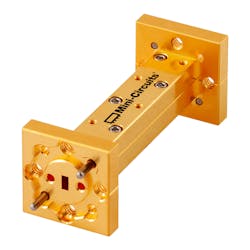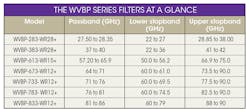Demand for higher frequencies continues to escalate as relatively lower frequencies at RF and microwave bands become more congested with countless personal communications applications. Responding to that demand, even long-time suppliers of RF/microwave components, such as Mini-Circuits, are reaching higher in frequency, teaming with outstanding engineering partners such as Virginia Diodes on a line of waveguide bandpass filters (BPFs) with sharp cutoff responses for passbands from 27 to 86 GHz.
These are almost “textbook” BPFs, with high stopband rejection, low passband loss, and abrupt transitions from passbands to stopbands. Millimeter-wave (mmWave) frequencies are moving quickly from the laboratory to the production line for such applications as short-range, high-data-rate communications links, 5G cellular communications, and radar systems in automotive safety systems. In turn, these filters provide practical solutions for sorting and separating those mmWave signals without penalties in amplitude.
Virginia Diodes (Charlottesville, Va.) brings expertise in the design and development of mmWave- and terahertz-frequency devices, components, and systems, including mixers, detectors, and frequency multipliers for systems and test equipment. The company began with strong interests in the use of higher-frequency electronics for astronomy. In recent years, however, the growing use of wireless applications has pushed the application of electromagnetic (EM) energy onward through the THz range. And, now, teaming with Mini-Circuits has resulted in a rugged, practical line of waveguide BPFs that are well-suited for test, research, and communications systems use.
This precision machined and plated rectangular waveguide filter is an example of the WVBP Series of mmWave bandpass filters for passbands from 27 to 86 GHz.
The WVBP Series of rectangular waveguide BPFs (see figure) are precision-machined components built to handle the demands of attach/detach test and communications-systems applications while contributing minimal distortion. The devices feature sharply defined passbands (see table) with low passband loss through 86 GHz.
The 50-Ω, RoHS-compliant waveguide filters achieve rapid transitions from rejection bands to passbands, with impressive loss behavior throughout the series of filters. For example, model WVBP-283-WR28+ is the lowest-frequency waveguide BPF, with a passband of 27.5 to 28.35 GHz, typical passband insertion loss of 0.5 dB, and typical passband return loss of 18 dB. It blocks unwanted out-of-band signals by means of typical lower stopband rejection of 65 dB at 22 GHz and 30 dB at the 27-GHz point, just below the passband. Just above the passband, the upper stopband rejection rises very quickly, typically 39 dB at 28.85 GHz, and still 31 dB at the upper stopband measuring point of 38 GHz.
The highest-frequency filter, model WVBP-833-WR-12+, has a passband of 81 to 86 GHz. Typical passband insertion loss is 0.5 dB while typical passband return loss is 26 dB. Typical lower stopband rejection is 90 dB at 60 GHz and 38 dB at 70 GHz, while typical upper stopband rejection is 26 dB at 88 GHz and 49 dB at 90 GHz. In between, several filters are available for different passbands, such as the model WVBP-383-WR28+ with a passband of 37 to 40 GHz, the model WVBP-673-WR12+with passband of 64 to 71 GHz, and the model WVBP-783- WR12+ with passband of 76 to 81 GHz.
All of the filters share the characteristics of sharp transitions from passband to stopbands, low passband insertion loss (typically 0.5 dB and no higher than about 1.0 dB even for the highest-frequency models), and low passband return loss (typically 26 dB even for the highest-frequency models).
If anything, Mini-Circuits and Virginia Diodes joining forces creates a path toward bringing mmWave filtering “to the masses,” whether for installation in systems or use in test setups. The move upward in frequency is all but inevitable, given the growing consumption of available frequency bands, and these filters provide the performance at mmWave frequencies that Mini-Circuits’ customers have come to expect for 50 years at lower frequencies.
Mini-Circuits, P.O. Box 350166, Brooklyn, NY 11235-0003; (718) 934-4500.



